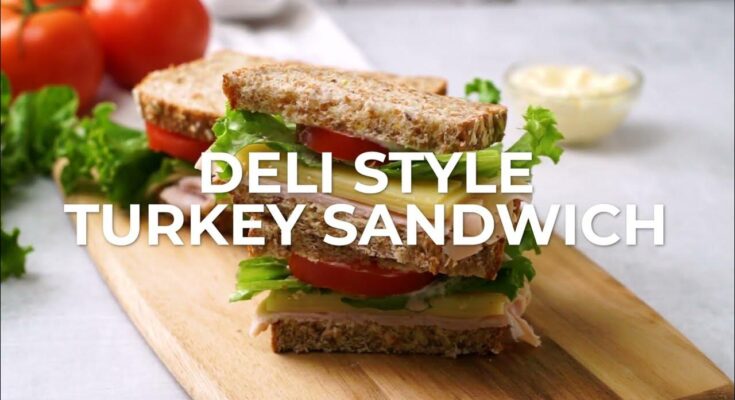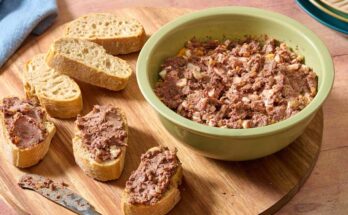Turkey Sandwich Recipe: There’s something timeless about a turkey sandwich. It’s the kind of meal that checks all the right boxes: simple to make, satisfying to eat, and endlessly customizable. Whether you’re whipping one up after a holiday feast with leftovers or assembling a quick lunch in the middle of a busy workday, a turkey sandwich delivers both in flavor and convenience.
Turkey itself is a lean, high-protein meat that pairs well with a variety of flavors and textures. Unlike other sandwich meats that can be greasy or overly salty, turkey has a mild taste that makes it the perfect base for all sorts of delicious combinations. Throw in your favorite bread, a few fresh vegetables, a slice of cheese, and your choice of condiments, and you’ve got a meal that feels both comforting and gourmet.
When and Where to Enjoy a Turkey Sandwich
The versatility of a turkey sandwich is what makes it such a crowd-pleaser. It’s perfect for lunch at the office, a picnic in the park, a post-workout meal, or even a late-night snack. You can make it light and healthy with greens and whole-grain bread, or go all out with melted cheese, crispy bacon, and hearty spreads.
It also adapts to the seasons. In the summer, keep it fresh and cool with tomato, cucumber, and sprouts. In the fall and winter, go for toasted bread, cranberry sauce, and warm turkey slices. The possibilities are endless—and that’s what makes mastering a good turkey sandwich recipe a kitchen must.
Ingredients You’ll Need
Essential Ingredients
Before diving into the step-by-step guide, you’ll need to gather your ingredients. At its core, a turkey sandwich is simple, so quality matters. Here are the essentials:
- Bread: Two slices of your preferred type (sourdough, whole grain, ciabatta, etc.)
- Turkey: 4-6 ounces of sliced cooked turkey (deli style or leftovers)
- Cheese: One or two slices (Swiss, cheddar, provolone, or your favorite)
- Condiments: Mayonnaise, mustard, or any sandwich spread you prefer
- Vegetables: Lettuce, tomato slices, red onions
These basics will give you a classic, flavorful sandwich. Want to elevate it even more? Add-ons will do the trick.
Optional Add-ons for Extra Flavor
Add-ons are where you can make your sandwich uniquely yours. Here are some tasty extras to consider:
- Avocado slices or guacamole
- Bacon strips, crispy and hot
- Pickles or banana peppers for tang
- Cranberry sauce (especially good with Thanksgiving leftovers)
- Spinach, arugula, or sprouts for greens
- Hot sauce, pesto, or honey mustard for extra zing
Don’t be afraid to experiment. Mix and match until you find your perfect combo!
Choosing the Right Bread
Best Bread Types for Turkey Sandwiches
Not all bread is created equal when it comes to sandwiches. The bread you choose can make or break the final result. For a turkey sandwich, you want something that holds up well but doesn’t overpower the ingredients. Here are some top choices:
- Sourdough: Tangy and hearty, adds complexity
- Ciabatta: Rustic and chewy, great for toasted versions
- Whole grain: Nutty and healthy, perfect for lighter options
- Rye or multigrain: Dense with lots of flavor
- White sandwich bread: Soft and simple for a classic feel
If you’re making a hot sandwich, opt for something with a firmer crust like ciabatta or a baguette. For a cold sandwich, softer bread works just fine.
Toasted or Fresh? What’s Better?
Toasting is a personal preference, but it can change the whole vibe of your sandwich. Toasting adds crunch and warmth, which pairs beautifully with melted cheese or warm turkey. On the flip side, untoasted bread offers a softer, more traditional texture.
To toast or not to toast? Here’s how to decide:
- Toast it if you’re using melty cheese, hearty fillings, or eating it warm.
- Keep it fresh for a light, refreshing lunch or when using soft ingredients like avocado or tomato.
If you do toast it, don’t overdo it—lightly golden is all you need.
Preparing the Turkey
Using Leftover Turkey vs. Fresh Sliced
One of the best things about turkey sandwiches is how well they work with leftovers. That said, both leftover turkey and freshly sliced deli turkey have their perks:
- Leftover turkey (from a roasted bird) offers a more rustic, homemade flavor. It’s juicy, tender, and can be served warm or cold.
- Deli turkey is convenient, consistent, and easy to store. It’s great for a quick grab-and-go meal and pairs nicely with a variety of flavors.
If you’re using leftovers, slice the turkey thinly for even layering. You can also reheat it briefly in a skillet with a little butter or broth for extra juiciness.
Tips for Juicy and Flavorful Turkey
Dry turkey can ruin your sandwich. Here are a few tips to keep it moist and tasty:
- Use dark meat (like thigh) if you prefer a richer flavor and more moisture.
- Layer it thick, but not too thick—you want balance with other ingredients.
- Add moisture with sauces or condiments if the turkey is on the drier side.
- Warm it up slightly to release its natural juices if using leftovers.
Building Your Turkey Sandwich – Step-by-Step
Step 1: Toast the Bread (Optional)
Pop your bread slices in a toaster or on a skillet. Toast until golden brown but still soft inside. If you’re making a panini-style sandwich, you can butter the outside of the bread for that crispy finish.
Step 2: Spread the Condiments
Spread your choice of condiments evenly on both slices of bread. This could be classic mayo, a layer of mustard, or a specialty sauce. Go light or heavy based on your taste, but make sure it covers edge to edge for full flavor in every bite.
Step 3: Layer the Turkey
Place your turkey slices evenly across one piece of bread. Avoid piling too high—about 4–6 ounces is ideal. Make sure the turkey covers the whole surface for consistent bites.
Step 4: Add Cheese and Veggies
Add your cheese next. Then, pile on your favorite veggies—crisp lettuce, ripe tomatoes, thinly sliced onions, cucumbers, or even a bit of avocado. Try to layer evenly to prevent the sandwich from falling apart.
Step 5: Finish and Slice
Top it off with the second slice of bread. Gently press down, then slice in half (diagonally is classic). Serve with chips, a pickle, or a small salad.
Customizing Your Turkey Sandwich
Healthy Options
Trying to keep it light? You can still enjoy a turkey sandwich without loading up on calories. Here are some healthy swaps and additions:
- Use whole grain or low-carb bread: Adds fiber and nutrients.
- Opt for lean turkey breast: Lower in fat, higher in protein.
- Skip heavy spreads: Use mustard, hummus, or Greek yogurt instead of mayo.
- Pile on the veggies: Add spinach, cucumbers, bell peppers, or sprouts for crunch and nutrition.
Also, watch your portion sizes. You don’t need a massive sandwich to feel full—just make it balanced and packed with clean, whole ingredients.
Gourmet Variations
Want to take your turkey sandwich to the next level? Try these elevated versions:
- Turkey, brie, and apple sandwich: Sweet and savory with thin apple slices and creamy brie.
- Cranberry turkey panini: Add stuffing, cranberry sauce, and grill it up for Thanksgiving vibes year-round.
- Turkey club: Triple-decker with bacon, lettuce, tomato, and mayo—classic diner style.
- Pesto turkey melt: Turkey, mozzarella, sun-dried tomatoes, and a pesto spread grilled until golden.
The beauty of the turkey sandwich lies in how well it pairs with gourmet ingredients. Don’t hold back—try unique cheeses, sauces, and textures.
Side Dishes That Pair Perfectly
Classic Sides
A sandwich isn’t complete without a good side. Some tried-and-true pairings include:
- Potato chips or kettle chips: Crunchy and salty, they contrast well with the soft sandwich.
- Pickles: Tangy and crisp, a perfect palate cleanser.
- Coleslaw: Creamy or vinegar-based, it adds a fresh element.
- French fries or sweet potato fries: Great for a more indulgent meal.
If you want to keep it casual and comforting, you can’t go wrong with these options.
Healthy Pairings
If you’re eating clean or just want a lighter meal, pair your turkey sandwich with:
- Mixed greens salad: Add nuts, seeds, and a vinaigrette.
- Fruit salad: A mix of fresh berries, melon, or citrus pairs great with turkey.
- Roasted veggies: Carrots, zucchini, or asparagus make a great warm side.
- Soup: A warm bowl of tomato or veggie soup complements the sandwich wonderfully.
These combos will give you a filling but balanced meal.
Making It Kid-Friendly
Turkey sandwiches are great for adults, but they can also be made kid-approved with a few tweaks:
- Use soft white or whole wheat bread: Easy to chew and familiar.
- Skip strong-flavored veggies: Use simple ones like cucumber or lettuce.
- Go light on condiments: Kids may prefer plain mayo or none at all.
- Cut into fun shapes: Use cookie cutters for a creative lunchbox surprise.
You can even turn it into a mini sandwich by using slider buns or Hawaiian rolls, perfect for smaller hands and appetites.
Meal Prep and Storage Tips
Prepping Ahead of Time
Turkey sandwiches are great for meal prep, especially if you’re packing lunches. Here’s how to do it:
- Prep ingredients separately: Store bread, meat, and veggies in different containers to avoid sogginess.
- Assemble the night before: If you must prep ahead, keep wet ingredients in the middle to avoid soaking the bread.
- Wrap it tight: Use foil or parchment paper, then store in an airtight container.
Avoid adding tomatoes or cucumbers ahead of time—they tend to make the sandwich soggy.
Storing Leftover Sandwiches
If you’ve made an extra sandwich and want to save it:
- Refrigerate immediately in a sealed container.
- Eat within 1–2 days for best taste and freshness.
- Reheat in a skillet or microwave if you used toasted bread or warm fillings.
Just keep in mind that texture and flavor are best when sandwiches are freshly made.
Turkey Sandwich Variations Around the World
International Takes on the Turkey Sandwich
While the classic American turkey sandwich is beloved, many cultures have their own delicious twists:
- France: Turkey baguette with brie and Dijon mustard.
- Mexico: Torta with turkey, avocado, jalapeños, and queso fresco.
- Vietnam: Turkey bánh mì with pickled veggies, sriracha mayo, and cilantro.
- India: Spicy masala turkey sandwich with chutney and onions.
Each of these brings its own flair, spices, and textures to the table. If you’re a foodie, trying global versions of the turkey sandwich is a fun way to mix up your routine.
Troubleshooting Common Turkey Sandwich Mistakes
Avoiding a Dry Sandwich
One of the most common complaints with turkey sandwiches is dryness. Luckily, there are several ways to fix or avoid this issue:
- Use moist ingredients like tomatoes, pickles, or avocado.
- Don’t skimp on spreads. A good smear of mayo, mustard, hummus, or even cranberry sauce adds essential moisture.
- Warm up your turkey slightly before adding it to the sandwich. A quick 15 seconds in the microwave or skillet can do wonders.
- Layer strategically. Place wetter ingredients near the meat to keep the whole sandwich juicy.
Avoid over-toasting the bread too—this can soak up moisture and make your sandwich feel tougher than it needs to be.
Keeping the Sandwich from Falling Apart
Turkey sandwiches can get messy if not built right. Here’s how to keep it tidy:
- Use sturdy bread. Soft, fresh bread is great, but it needs to be firm enough to hold ingredients.
- Layer ingredients evenly. Don’t pile all the fillings in the middle.
- Cut sandwiches correctly. A diagonal cut helps distribute fillings more evenly and makes it easier to hold.
- Wrap it tight. If you’re packing it to go, wrap it in parchment or foil to keep everything in place.
It’s all about balance—between flavor, moisture, and structure.
Nutritional Value of a Turkey Sandwich
What’s in a Classic Turkey Sandwich?
Depending on what you put in it, your turkey sandwich can be a wholesome meal. Here’s a rough nutritional estimate for a standard build:
| Component | Calories | Protein | Fat | Carbs |
|---|---|---|---|---|
| Whole grain bread (2 slices) | 160-200 | 6-8g | 2-4g | 24-30g |
| Turkey (4 oz) | 120-150 | 25-30g | 2-3g | 0g |
| Cheese (1 slice) | 70-110 | 5-7g | 5-9g | 1g |
| Lettuce, tomato | 10-15 | <1g | 0g | 2-3g |
| Mayo or mustard | 50-100 | 0g | 5-10g | 1g |
Total: Approximately 400–600 calories, 30–40g of protein, moderate fat, and a solid carb base—perfect for energy and satiety.
Ways to Make It Even Healthier
- Go open-faced to cut carbs.
- Use low-fat cheese or skip it entirely.
- Swap mayo for mustard or avocado.
- Add extra greens for fiber and vitamins.
- Use lean turkey breast only for less fat.
This makes your sandwich not just delicious but part of a balanced diet.
Serving Ideas and Presentation Tips
Making It Look as Good as It Tastes
A beautifully presented sandwich feels more like a meal. Here’s how to style your turkey sandwich:
- Use a serrated knife for a clean, diagonal cut.
- Add a colorful side like bright pickles, chips, or a salad.
- Serve on a wooden board or plate with a napkin tucked under.
- Use a sandwich toothpick to hold multi-layered sandwiches together.
Add a sprig of herbs like rosemary or parsley on the plate for that gourmet touch.
When to Serve It
Turkey sandwiches are perfect for many occasions:
- Quick lunches
- Picnic or road trip meals
- Party platters
- Game day spreads
- Brunch with a twist
No matter when or how you serve it, your turkey sandwich can be a hit with just a bit of presentation love.
FAQs about Turkey Sandwich Recipe
1. Can I freeze turkey sandwiches for later?
Yes, but it’s best to freeze the components separately. Bread and turkey freeze well, but avoid freezing veggies or mayo-based spreads—they don’t thaw nicely.
2. What cheese pairs best with turkey?
Swiss, provolone, cheddar, or mozzarella are popular options. For something bold, try gouda or brie.
3. How do I keep my sandwich from getting soggy?
Layer wet ingredients in the middle, toast the bread lightly, and wrap tightly if packing it to go.
4. Is turkey sandwich good for weight loss?
Yes—if you use lean turkey breast, whole grain bread, and skip heavy condiments. It’s high in protein and can be low in fat.
5. Can I make a turkey sandwich without bread?
Absolutely! Use lettuce wraps, low-carb tortillas, or even sliced sweet potatoes as the base.
Conclusion
A turkey sandwich is more than just meat between bread—it’s a blank canvas for creativity, flavor, and balance. From the bread you pick to the toppings and condiments you choose, every part of the sandwich plays a role. Whether you’re going for classic simplicity or a gourmet twist, following these tips ensures every bite is delicious, juicy, and satisfying.
Don’t be afraid to experiment. The best sandwiches often come from mixing unexpected ingredients and trying new flavor combos. So next time you’re staring into your fridge wondering what to make—remember, the humble turkey sandwich has got your back.



